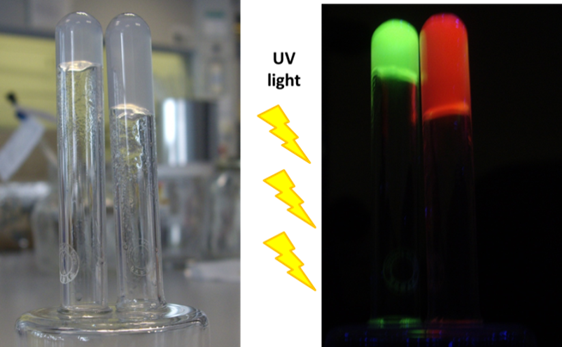Chemists Make Self-Healing, Luminescent Wonder Gels
Posted on: 05 May 2015
Chemists from Trinity College Dublin followed their own unique recipe to cook up a breakthrough that could have significant applications in skin graft operations and in protecting valuable electronics and vehicles.
Led by Professor of Chemistry at Trinity, Thorri Gunnlaugsson, the collaborative team has established how to quickly and cheaply create self-healing, luminescent gels, which will have a variety of uses in fields spanning science, medicine and electronics.
The gels are formed when individual molecules (ligands) and the lanthanide metal ions europium and terbium (currently used in luminescent counterfeiting in Euro notes) interact with one another. Varying the ion ratios preferentially means the gels will emit a luminous colour of choice when light is shined through.

Such a property is greatly desired because it means the gels could be used in a variety of sensors; they could morph in colour if something changes in the immediate environment to act as reliable and specific indicators of such a change. That system will have applications in biomedical imaging and drug delivery within cells – areas the chemists are currently pursuing, having received funding from Science Foundation Ireland in 2014 through the Principle Investigation Programme.
Dr Oxana Kotova, Research Fellow in Chemistry at Trinity, is the joint-lead author on the paper, which has just been published in the international peer-reviewed Journal of the American Chemical Society.
She said: “The luminescence, which we can vary in a range of colours, makes these gels extremely useful, but we are just as excited about their self-healing abilities as this opens up a whole world of possibilities.”
She added: “Because the gels exist as large networks of molecules, whose many individual weak interactions together form a much stronger matrix, they can be ‘pulled apart’ from any angle. However, these same properties mean that the gels will re-form, or ‘self-heal’ when meeting other gels of the same type.”
This means the gels should have a variety of uses where materials – living, such as human flesh, or dead, such as the screens of smartphones, televisions, or the shiny metallic outer surfaces of cars – might need to be repaired seamlessly to cover up any hints of scarring.
Professor Gunnlaugsson added: “We are really excited for the future – if we could find ways to make these gels biodegradable, there is no reason why we couldn’t use them to heal up patients’ wounds perfectly. And that’s just one possible application of a great many.”
Professor Gunnlaugsson and Dr Oxana worked closely with Research Professor and Head of Physical, Computational and Materials Chemistry, John Boland (CRANN), and Assistant Professor in Physics, Matthias Mo?bius, on this project. Dr Miguel Martínez-Calvo, a researcher and co-author of this work from the Gunnlaugsson group, made the initial discovery.
Media Coverage:
